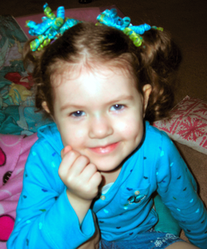Basic Advice for Parents of Toddlers:
You are responsible for when, where, and what to serve your child. In other words, if you don't want your child to get used to eating junk food, don't make it one of the options.
Also, if you want your child to eat at the table, make that the place where food is served.
Even if your child refused to eat broccoli yesterday, you can still choose to offer it again today. It has been said that you may have to offer something 17 times before a child will try it. Just offer it, but don't force the issue. When a child has seen it and smelled it and gotten used to the idea of it (as long as they don't feel forced), they just may decide to try it and find out they really do like it after all. (Think of the book Green Eggs and Ham, by Dr. Seuss.)
The child, on the other hand, decides if and how much to eat.
Strange as it may seem, young children know when they're hungry and when they've had enough and are full. For the child's future health, you don't want to interrupt the natural hunger cues that your child has built into his system and that he can learn to recognize. Yes, you want to be sure you feed your child healthy and nutritious food, but it's not a good idea to overfeed, either. Insisting a child continues eating after he's no longer hungry can lead to obesity later on. So can linking eating to emotions.
Other things that can affect a child's eating habits are the child's temperament and the child's metabolism. Very active children whose bodies burn a lot of calories may just need to eat more than a child whose metabolism is slower.
Children also use food to assert their independence. If you let them sometimes choose between two things -- for instance, two kinds of cereal or two kinds of sandwiches -- they can learn that they have some say in what they eat and so may not need to assert their autonomy through food.







 Children Learn Through Playon 09/17/2015
Children Learn Through Playon 09/17/2015
 Boston Public Gardenon 06/19/2015
Boston Public Gardenon 06/19/2015
 Remembering the Supremeson 01/20/2014
Remembering the Supremeson 01/20/2014
 How to Help Your Baby Sleepon 09/14/2013
How to Help Your Baby Sleepon 09/14/2013



Comments: Tell Us Some of Your Food Experiences With Toddlers and Young Children!
Mira, I agree -- when kids are involved with food preparations, they're much more willing to taste the food. I'm fascinated by the in utero studies, too. Thanks for sharing those thoughts.
Frank, I have a nephew who was the same way and now towers over everyone. Some kids go through "food jags" when they will only eat certain colored foods (such as white) or one particular food. Still it's important to encourage good eating habits in kids.
Don't worry! My younger brother, as a young child was a very fussy eater, which upset my mother, as I at the same age was a human food consumption machine. As a young mother she got worked up and convinced herself that her baby would starve to death [Mother tended to get easily worked up.] But my level headed grandfather,her father, who generally tended to be right,simply said, "Don't worry. He will eat when he is hungry." He did. He is now the physically tallest of the Beswick males and never suffered any nutrition problems.
These are such great tips! I love it, for instance, when parents involve their children in the preparation of the meals. It takes a lot of patience, but it's worth it.
Looking at what 2uesday wrote, I'll add that I read that if the mother eats fast food when she's pregnant, this will develop a preference for fast food in the child. It's probably more a taste preference than anything else, but in any case, it seemed very interesting. As is the fact, proven or not, that the music the mother listens to when pregnant models the child's brain.
Great ideas, 2uesday! Sharing our own experiences can sometimes help someone else who is pulling out her hair trying to get a child to eat.
Pressure often makes matters worse. I agree with you that letting a child have choices between healthy options gives them some control without doing harm.
One of the strongest influences is making healthy choices in what we as adults eat. Especially very young children are great imitators!
I love your picnic idea, Lou, and the way you make eating fun for DD. That's what meal times are all about -- enjoying each other's company while we refuel our bodies.
I've tried a number of different things, one time when dd was going through her fussy stage I collected a small selection of food - arranged it on a plate as though I was setting a buffet table and then put down a picnic rug on the floor and placed the plate on that. DD asked for a picnic lunch on a regular basis after that and used to eat all of the healthy foods I had there.
I've also tried the count how many different colored foods we can eat in a day (she loved trying to beat me) or how many different types of foods we could eat in a day ........ she loved that idea :)
Thanks for the info! I can use all the help I can get!